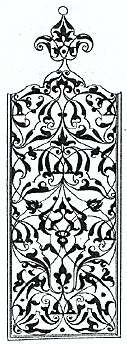Mauresque

The Mauresque (Moreske) is a plant ornament in the form of highly stylized linear tendrils , leaves and flowers. The motif developed in Assyria found its way into Islamic and Moorish art and was adopted from this during the Renaissance by the Occident , where it was relevant between 1520 and 1600.
The term is derived from that of the Moors , the Carthaginian - Roman name of the Berbers in North Africa (Spanish: los moros ).
The Mauresque consists of leaves and tendrils that are connected to each other. The rhythmic repetition of the motifs makes it possible to cover surfaces of any size. The basis is the ancient acanthus wavy tendril. However, the ornamentation is reduced to two dimensions, the tendrils are thinner, the curls less dominant.
At the end of the 15th century, many Islamic art objects came to Italy and served as models for Christian artists. Numerous pattern books with Mauresques appeared in the 16th century. At the end of the 16th century, the Mauresque merged with other forms of ornament in Europe. The Mauresque ornamentation on metal and leather work of historicism experienced a resumption .
The Mauresque differs from the arabesque in that it has a less naturalistic design and the absence of living beings.
Individual evidence
- ^ Lexicon AZ in two volumes , second volume, encyclopedia Volkseigener Verlag Leipzig 1957, p. 128
literature
- Günter Irmscher: Ornament in Europa 1450–2000, Cologne 2005, pp. 92–94